Introduction
Endless paperwork, delayed responses, and frustrated employees have become the norm.
But what if the solution isn't more people or bigger budgets?
What if it's a chatbot?
HR chatbots have emerged as game-changing tools for human resources professionals, enabling automated interactions across recruiting, onboarding, and employee support functions.
These HR AI chatbot solutions leverage advanced machine learning to provide instant, personalized responses to complex workforce queries.
This guide will show you the benefits of HR chatbots, real-world use cases, inspiring examples, and practical steps to create one. It’s simpler than you think.
Let’s begin.
What is an HR Chatbot?
An HR chatbot is an AI-powered tool designed to assist employees with HR-related tasks. It communicates in natural language, making it easy for employees to ask questions and receive instant responses.
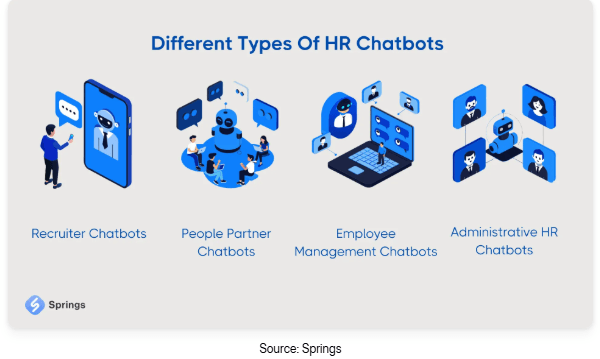
By integrating HR chatbot benefits into existing systems, organizations can dramatically improve efficiency and employee engagement.
Think of it as a smart assistant simplifying HR interactions.
Overview of How They Work
An HR AI chatbot represents a sophisticated technological solution that bridges advanced artificial intelligence with human resources management.
These HR chatbots leverage natural language processing (NLP) to comprehend and interpret employee inquiries with remarkable precision. The AI technology enables the HR chatbot to understand context, intent, and nuanced language, transforming traditional employee support mechanisms.
Integration is a critical component of HR chatbot functionality. These intelligent systems seamlessly connect with multiple HR systems, including payroll databases, attendance tracking platforms, benefits management software, and performance management tools.
This deep integration allows the HR chatbot to access real-time information, enabling it to provide accurate, personalized responses and execute complex tasks instantaneously.
The NLP algorithms powering HR chatbots utilize machine learning techniques to continuously improve their understanding and response capabilities.
By analyzing thousands of interactions, these AI-driven systems learn to recognize patterns, refine communication strategies, and develop increasingly sophisticated conversational abilities.
Through advanced AI and comprehensive system integration, HR chatbots are revolutionizing employee support, making HR interactions more efficient, responsive, and user-friendly.
The technological sophistication of these chatbots extends beyond simple question-answering. They employ advanced machine learning models that can understand context, sentiment, and even emotional nuances in employee communications, providing a more empathetic and intelligent support experience.
Key Functions
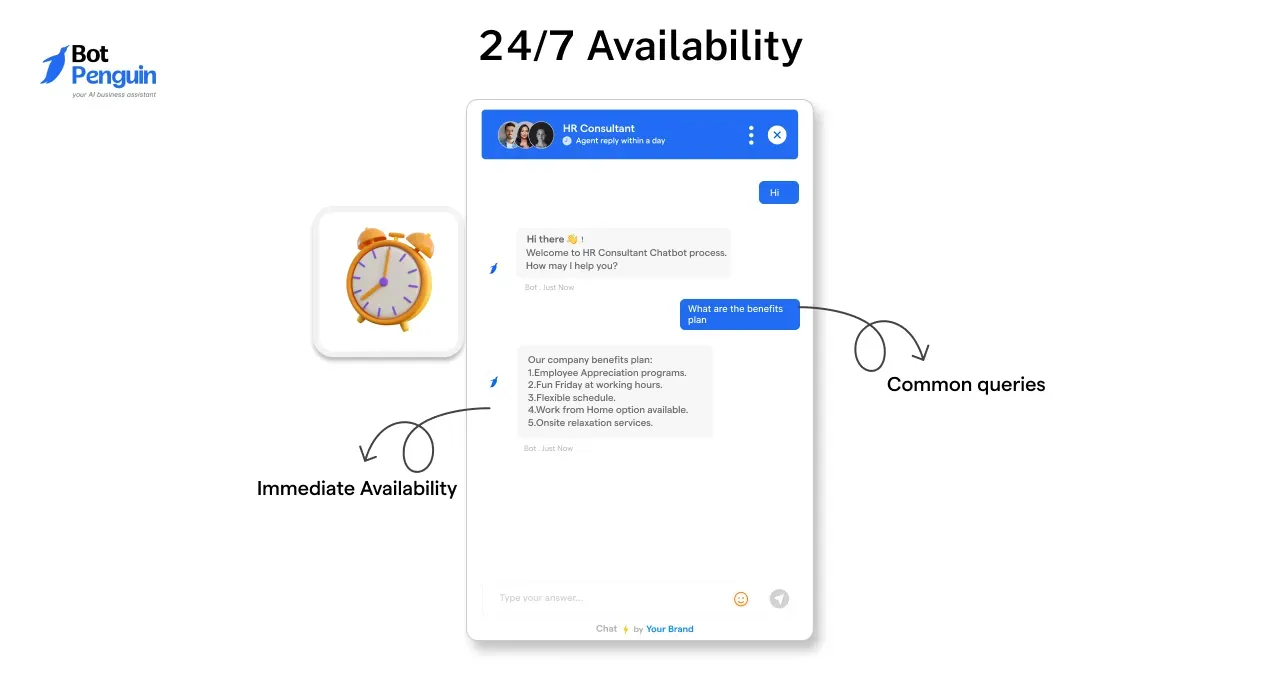
An HR bot serves as a comprehensive digital assistant that transforms employee-HR interactions.
By leveraging advanced artificial intelligence, these chatbots provide instant, accurate responses to frequently asked questions about company policies, benefits, payroll, and organizational procedures.
The bot's ability to handle routine inquiries allows HR professionals to focus on more strategic, high-value tasks that require human expertise and critical thinking.
HR chatbots offer 24/7 accessibility, ensuring employees can get support at any time, regardless of traditional office hours. This round-the-clock availability significantly enhances employee experience and reduces response waiting times.
Advanced HR bots incorporate machine learning algorithms that continuously improve their understanding and response accuracy.
They can personalize interactions based on individual employee profiles, past conversations, and specific departmental requirements. This intelligent personalization makes employees feel more supported and valued.
The data collected by HR bots also provides valuable insights for HR departments. By analyzing conversation patterns, frequently asked questions, and employee interactions, organizations can identify potential areas of improvement in policies, communication, and employee support mechanisms.
As organizations continue to embrace digital transformation, HR chatbots represent a critical tool in modernizing workplace communication and employee support strategies.
Benefits of HR Chatbots
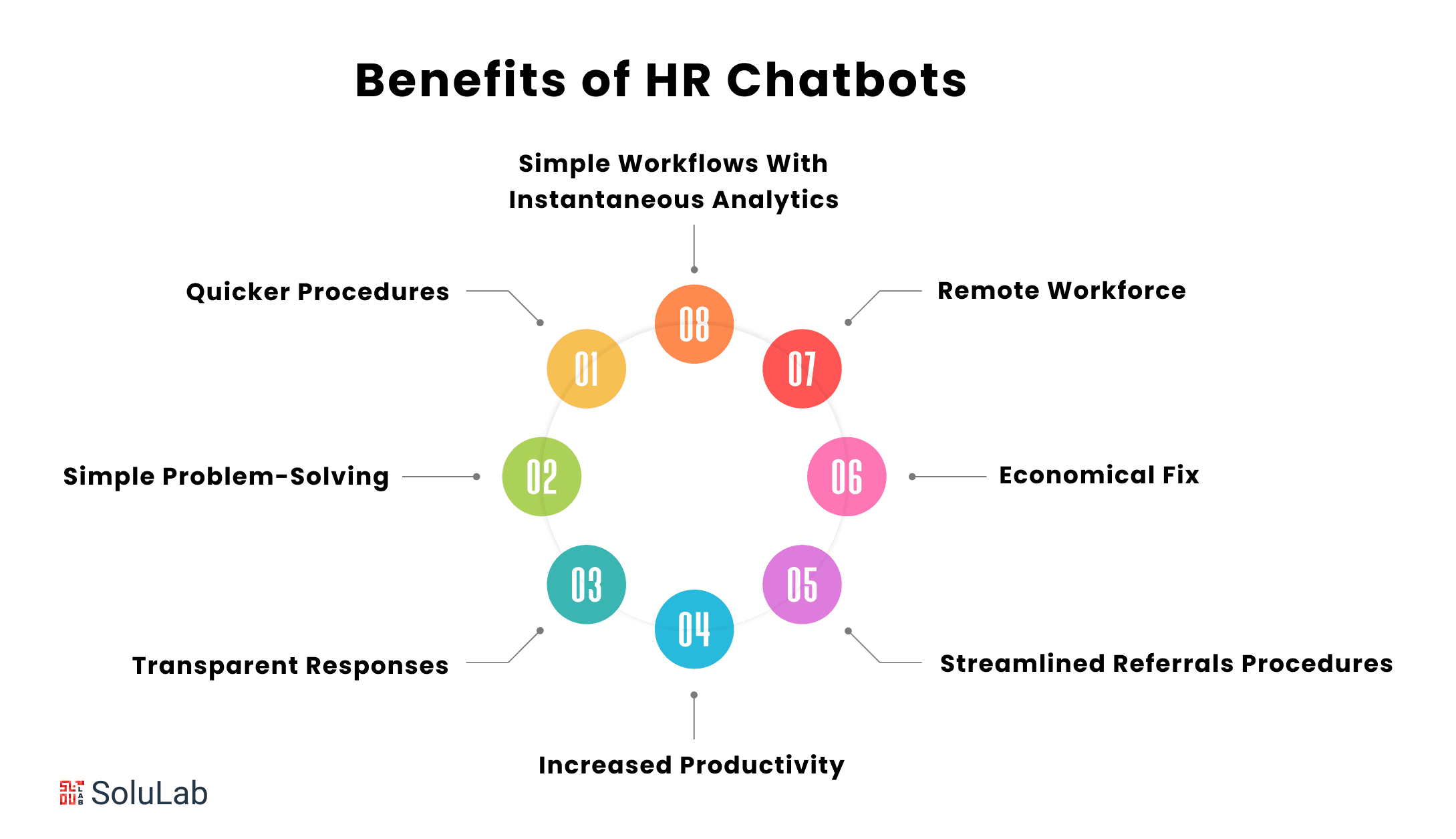
HR chatbots improve efficiency by automating repetitive tasks such as answering employee queries and scheduling interviews, freeing up HR professionals for strategic initiatives.
Additionally, they enhance employee engagement by providing instant, 24/7 support, creating a seamless communication experience.
Let’s explore how.
Improved Efficiency
An HR chatbot handles repetitive and time-consuming tasks like answering common questions or guiding employees through routine processes. This frees up HR teams to focus on strategic initiatives.
Consider an employee wants to know their remaining paid leave. Instead of waiting for HR to respond, the HR bot provides the information instantly. Similarly, tasks like resetting passwords or retrieving policy documents no longer require human intervention.
Another significant efficiency boost is 24/7 availability. Chatbots in HR allow employees to access support anytime, from anywhere. This is especially valuable for global teams operating across time zones.
Enhanced Employee Experience
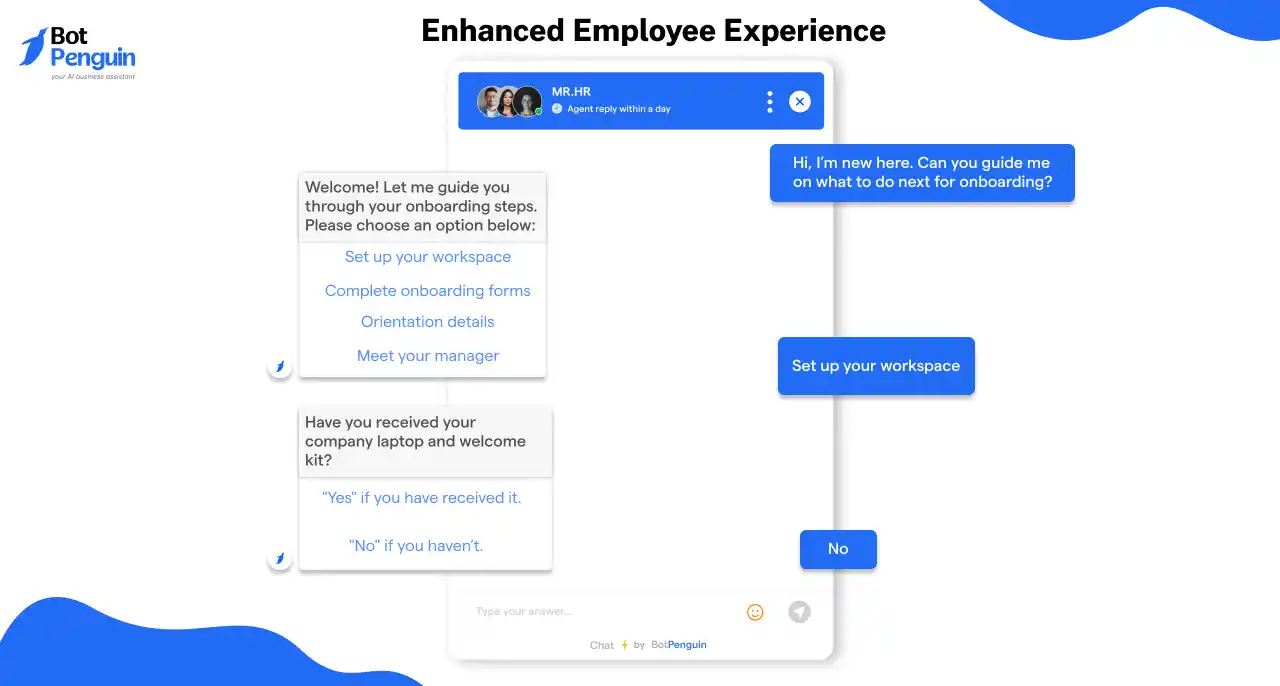
Employees expect fast and personalized support, and HR chatbots deliver just that. They respond instantly to common questions, reducing frustration.
For example, an employee onboarding in a remote setup can ask the chatbot for HR about the next steps and get real-time guidance.
With AI capabilities, an HR AI chatbot personalizes interactions. If an employee frequently asks about career growth opportunities, the bot might suggest relevant training resources. This tailored support makes employees feel valued and engaged.
Cost-Effectiveness
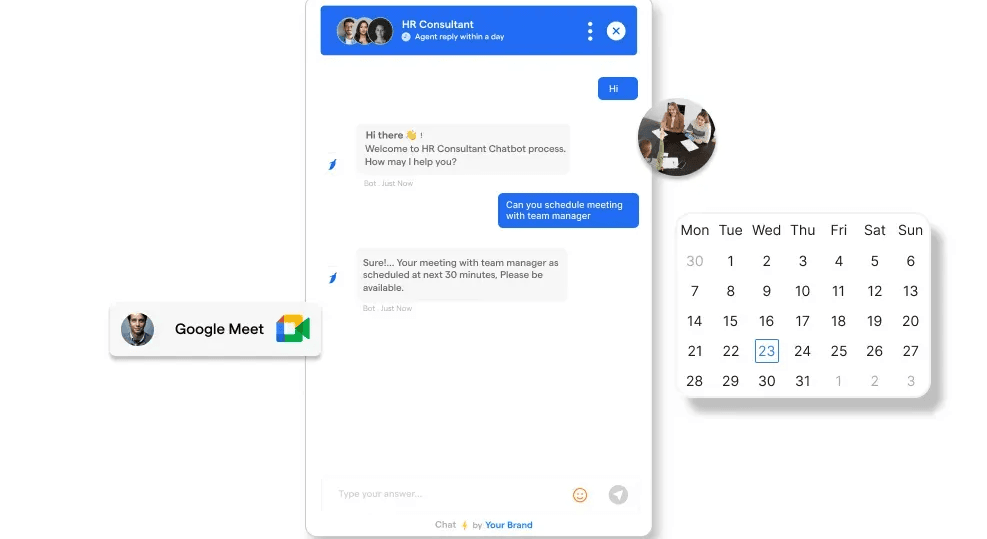
Adopting an HR chatbot reduces the need for a large HR team to handle mundane tasks. For growing businesses, this means scalability without proportionately increasing HR costs.
Picture a small company expanding rapidly. Instead of hiring additional HR staff to handle increased queries, they implement a human resources chatbot. It efficiently manages repetitive inquiries, allowing the company to allocate resources elsewhere.
This scalable model is one of the most notable HR chatbot benefits, ensuring that businesses can grow sustainably.
Data Collection and Insights
Every interaction with an HR bot generates valuable data. This includes tracking the most common employee queries or understanding patterns in satisfaction levels.
If employees ask about mental health support, HR can prioritize related initiatives. These insights from chatbots for HR can inform strategies, improving overall workplace satisfaction.
Onboarding and Training Support
An HR recruiting chatbot simplifies the onboarding process by guiding new hires through necessary steps like submitting documents or completing forms. It also shares learning materials, tracks progress, and ensures that employees feel supported.
Consider a new hire joining a large organization. Instead of navigating complex systems alone, they interact with the chatbot HR, which provides instructions and links to resources. This not only enhances productivity but also reduces overwhelm for the employee.
Use Cases for HR Chatbots
Let’s look into some real-world use cases that highlight the practical applications of chatbots in HR for better comprehension.
These practical applications not only simplify HR operations but also improve the overall employee experience, making HR processes faster, more efficient, and more engaging.
Recruitment
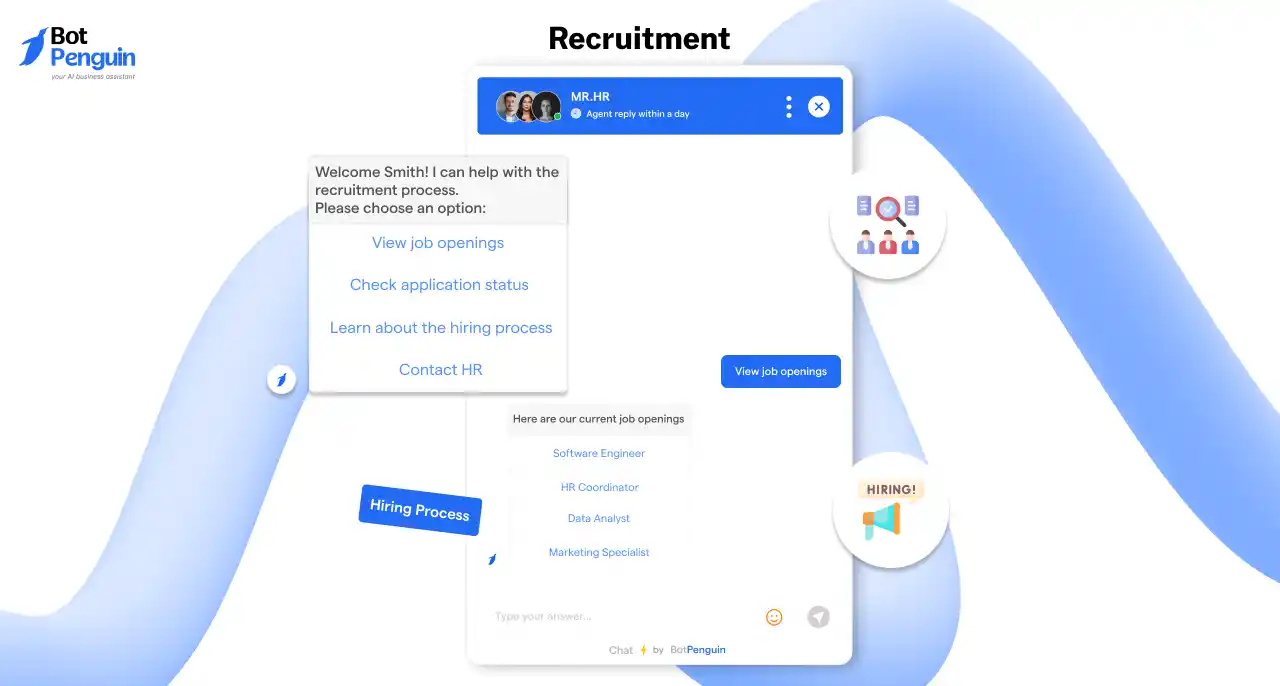
An HR recruiting chatbot simplifies the hiring process by handling initial candidate screening. Like, it can ask pre-set questions to evaluate qualifications and experience or shortlist only the most suitable candidates for HR review.
It also takes care of scheduling interviews. Imagine a company hiring for multiple roles across time zones. The HR bot coordinates with candidates and hiring managers to set up interviews, avoiding back-and-forth emails. This automation speeds up recruitment while reducing workload.
Onboarding
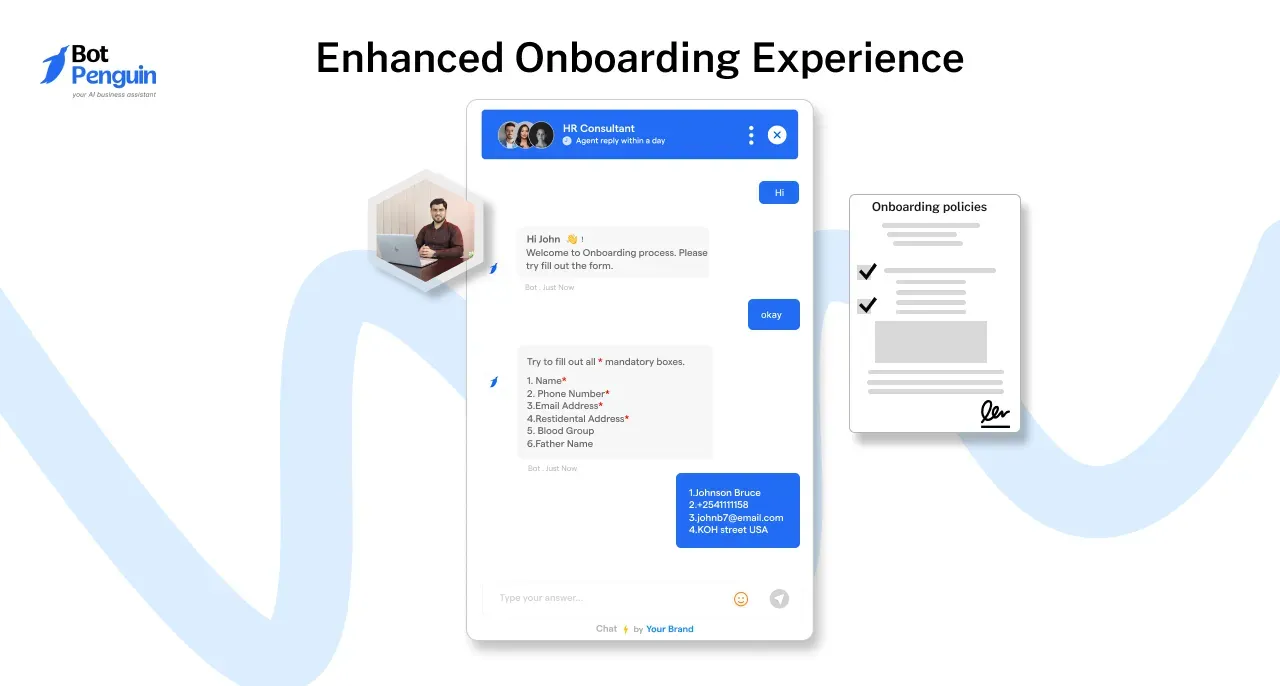
New hires often find onboarding overwhelming. An HR chatbot ensures a smoother experience by guiding them through paperwork, explaining company policies, and addressing FAQs.
To state an example a new employee in a remote setup can ask the chatbot for HR about submitting tax forms or accessing internal tools.
The chatbot provides step-by-step instructions, saving HR teams time and reducing confusion for the new hire.
Employee Support
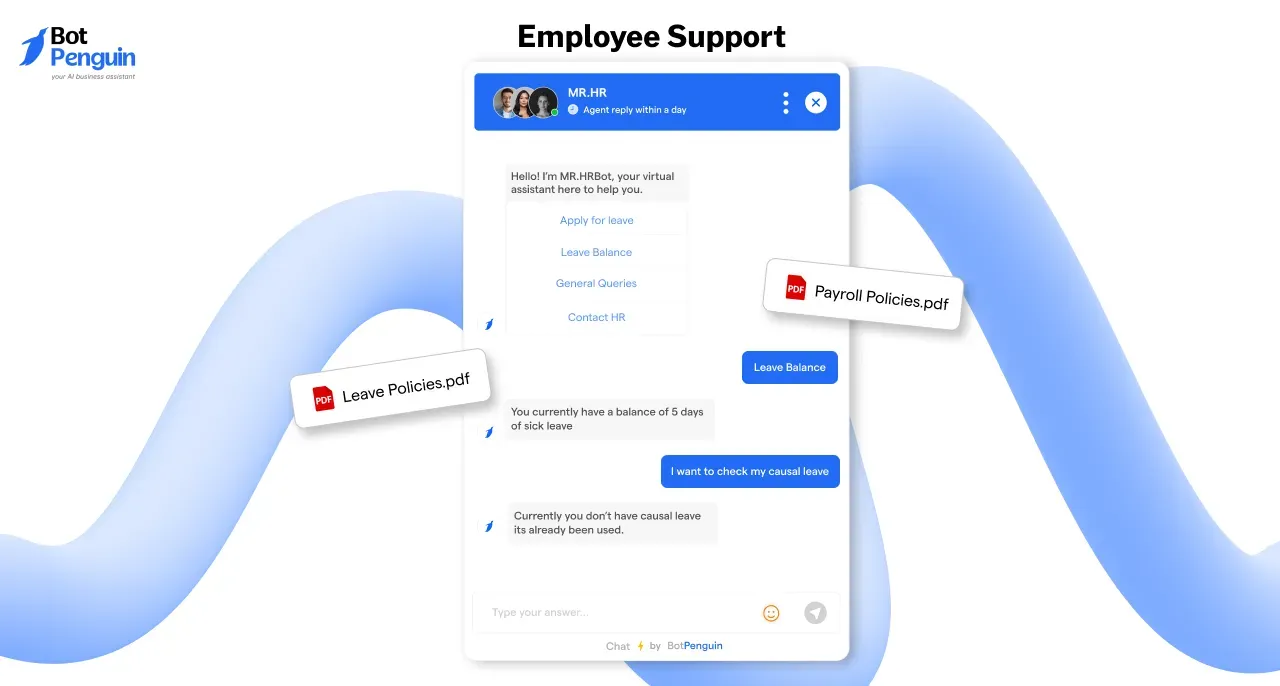
Handling employee queries is a major function of an HR AI chatbot. Whether it’s about leave policies, benefits, or payroll discrepancies, the chatbot provides instant answers, reducing frustration and wait times.
An employee worried about a payroll error can ask the human resources chatbot for help. The chatbot verifies the issue and either resolves it or directs it to the relevant HR personnel for further assistance. This proactive support keeps employees satisfied.
Training and Development
Continuous learning is crucial for employee growth, and chatbots for HR make it easier to manage training programs. They recommend courses based on roles and monitor progress.
After a performance review, an HR bot might suggest training modules to address skill gaps. It can also send reminders to ensure employees complete these programs on time, enhancing their professional development.
Employee Engagement
An often-overlooked use case of HR chatbots is fostering employee engagement. They send reminders about events, wellness programs, or deadlines, keeping employees informed. Additionally, they conduct pulse surveys or feedback sessions to gauge employee morale.
Before a company-wide wellness challenge, the HR chatbot sends personalized messages encouraging participation. Later, it collects feedback on the program's success, offering insights to HR teams.
Examples of HR Chatbots in Action
HR chatbots are making a tangible impact in organizations worldwide, simplifying processes, improving efficiency, and enhancing the employee experience.
Here are some examples showcasing the transformative impact of chatbots in HR.
Businesses Successfully Using HR Chatbots
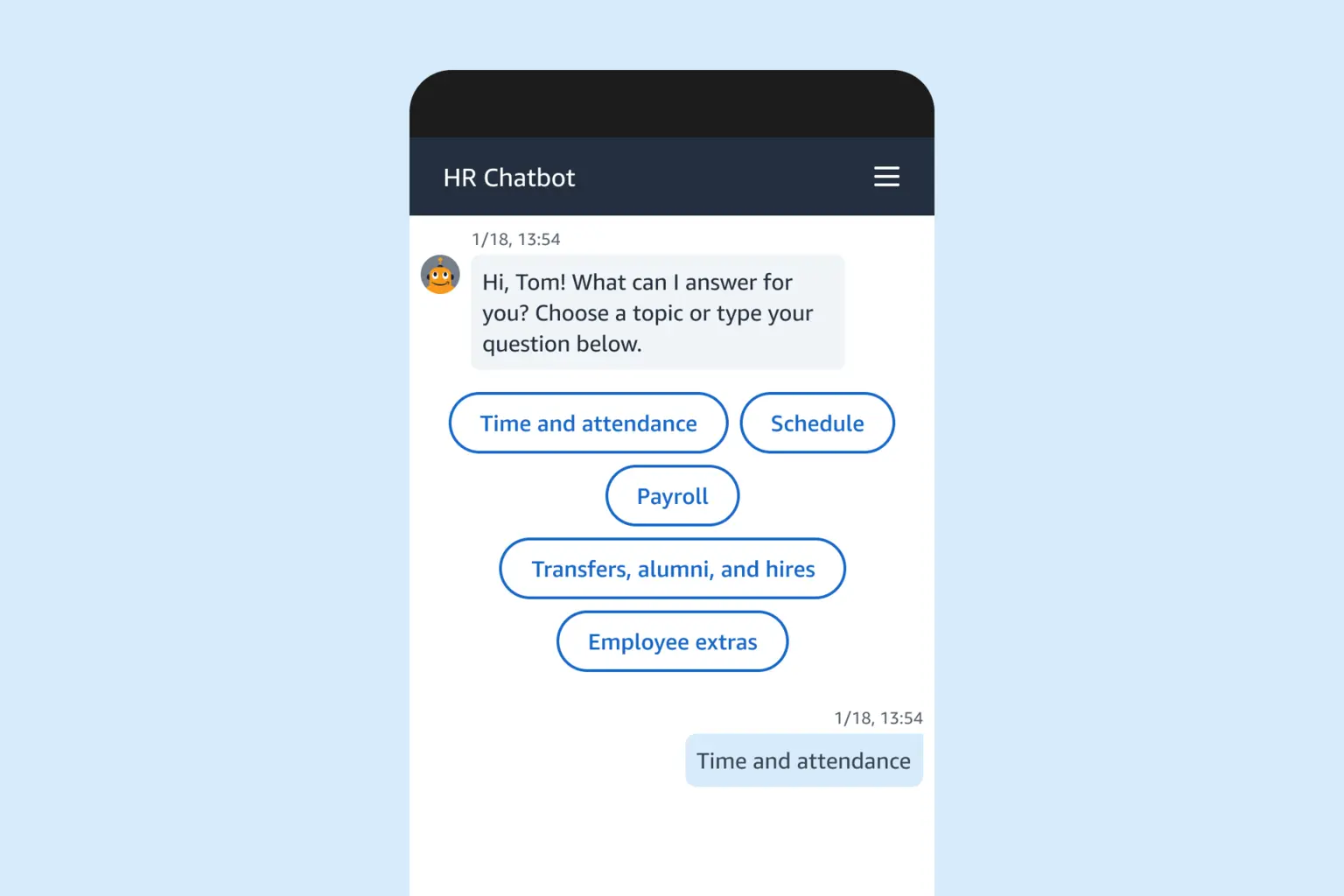
Amazon, one of the largest global employers, uses an HR AI chatbot called “Spencer” to support its employees. Spencer helps Amazon's vast workforce with common HR-related queries like leave policies, shift schedules, and payroll issues.
During peak seasons, when employee queries surge, the chatbot provides instant, accurate answers, reducing dependency on the HR team. This has significantly improved response times and employee satisfaction.
Unilever leverages an HR recruiting chatbot named “Unabot” to streamline its hiring process. The chatbot screens candidates, asks pre-set questions, and schedules interviews.
This has helped Unilever process thousands of applications faster, ensuring top talent is not missed while saving substantial time for HR managers.
Highlighting Measurable Improvements
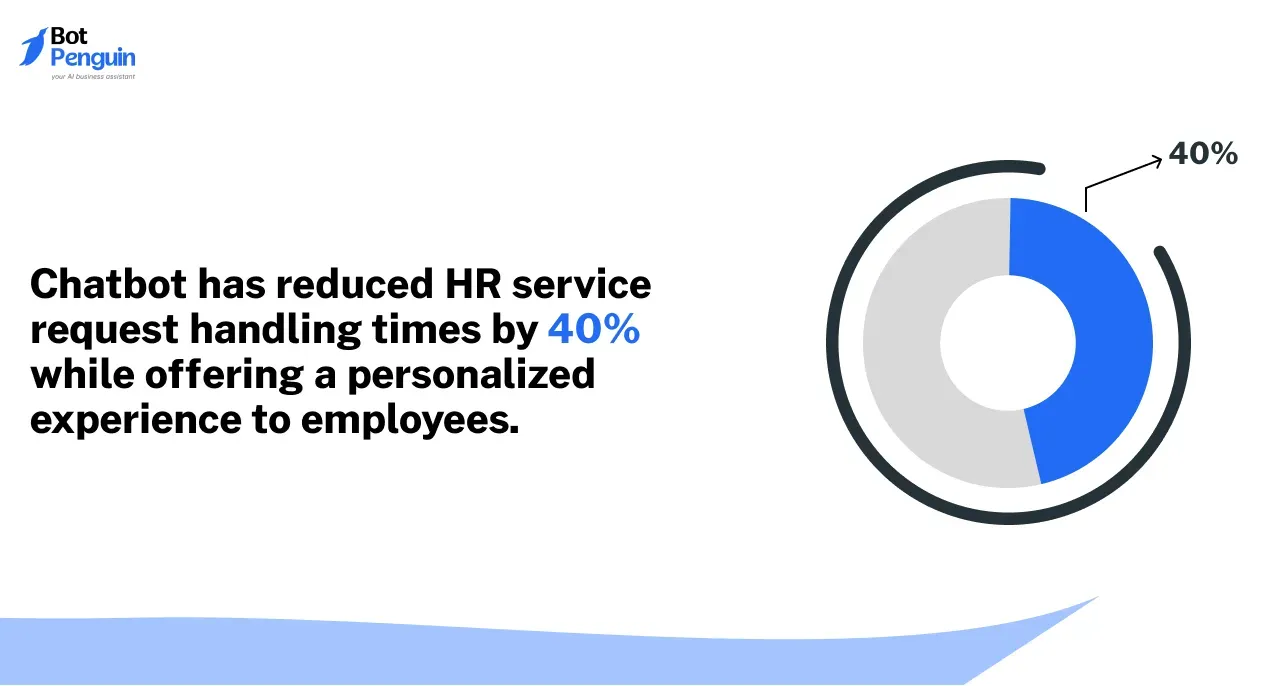
IBM integrated an HR chatbot named “AskHR” to assist its global workforce. Employees rely on AskHR for everything from understanding company policies to resolving IT issues related to HR platforms.
This chatbot has reduced HR service request handling times by 40% while offering a personalized experience to employees.
Another example comes from Coca-Cola, where a dedicated HR bot helps new hires during the onboarding process. It guides employees through paperwork, provides training material, and answers FAQs.
As a result, Coca-Cola reported a 25% reduction in onboarding time, ensuring that employees are productive from day one.
How to Create an HR Chatbot
Creating a functional and effective HR chatbot requires thoughtful planning, the right tools, and continuous optimization. Here’s a step-by-step guide to help you get started.
Here’s how to create a functional and effective chatbot for HR.
Step 1
Identify Your Needs
Start by defining the purpose of your human resources chatbot. Will it focus on recruitment, onboarding, or answering employee FAQs? Understanding its role helps determine key features and the target audience.
If your goal is recruitment, an HR recruiting chatbot should handle candidate screening and scheduling interviews. For employee support, features like answering payroll queries or sharing company policies are essential.
Step 2
Choose a Platform
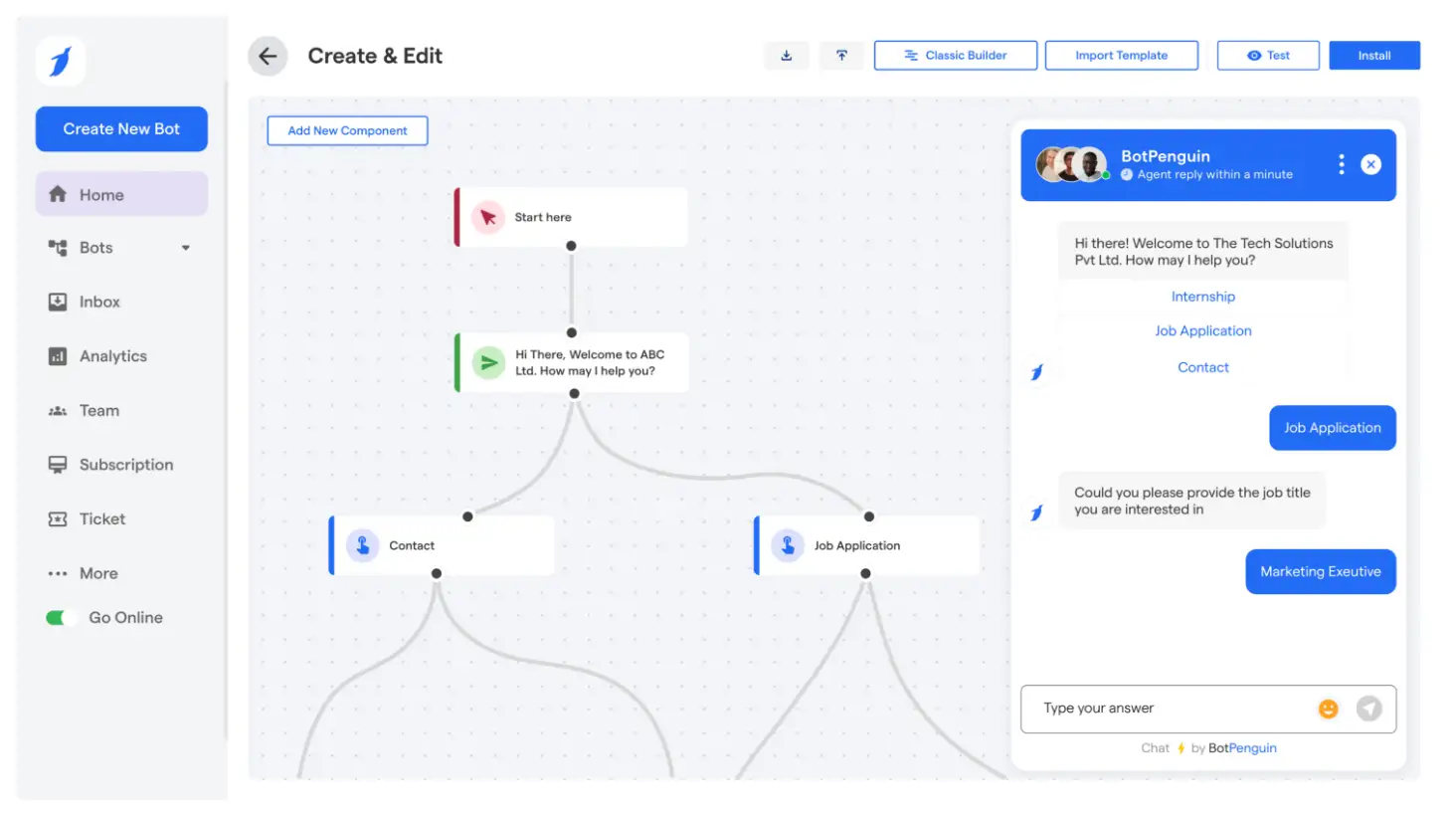
Decide whether to build the HR AI chatbot from scratch or use a pre-built solution. Platforms like BotPenguin, Microsoft Bot Framework, and Tars simplify the process for non-technical teams.
Building from scratch offers full customization but requires technical expertise, while pre-built tools are faster to deploy and cost-effective. Choose what aligns with your resources and timeline.
Step 3
Design the Workflow
Map out conversation scripts and workflows. Focus on natural, easy-to-understand language that reflects your company’s tone.
An HR bot handling leave requests should have a clear script guiding employees to input dates, check policy limits, and confirm approvals. Ensuring smooth navigation enhances user experience.
Step 4
Train the Chatbot
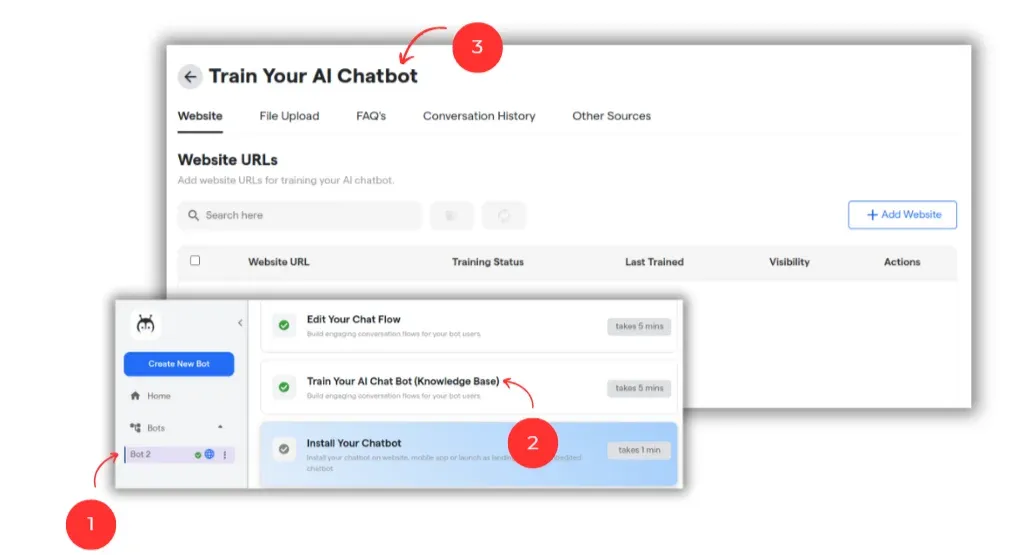
Feed the HR chatbot with relevant data like company FAQs, policies, and training resources. Use AI models to improve response accuracy over time.
An HR AI chatbot might start with basic knowledge of benefits and policies but improve through machine learning as employees interact with it.
Step 5
Test and Launch
Before rolling it out, test the chatbot for different scenarios. Check if it answers correctly, follows workflows, and resolves queries effectively.
Launch the chatbots for HR in phases, starting with a pilot group. Collect feedback, refine responses, and fix any issues before scaling.
Step 6
Monitor and Optimize
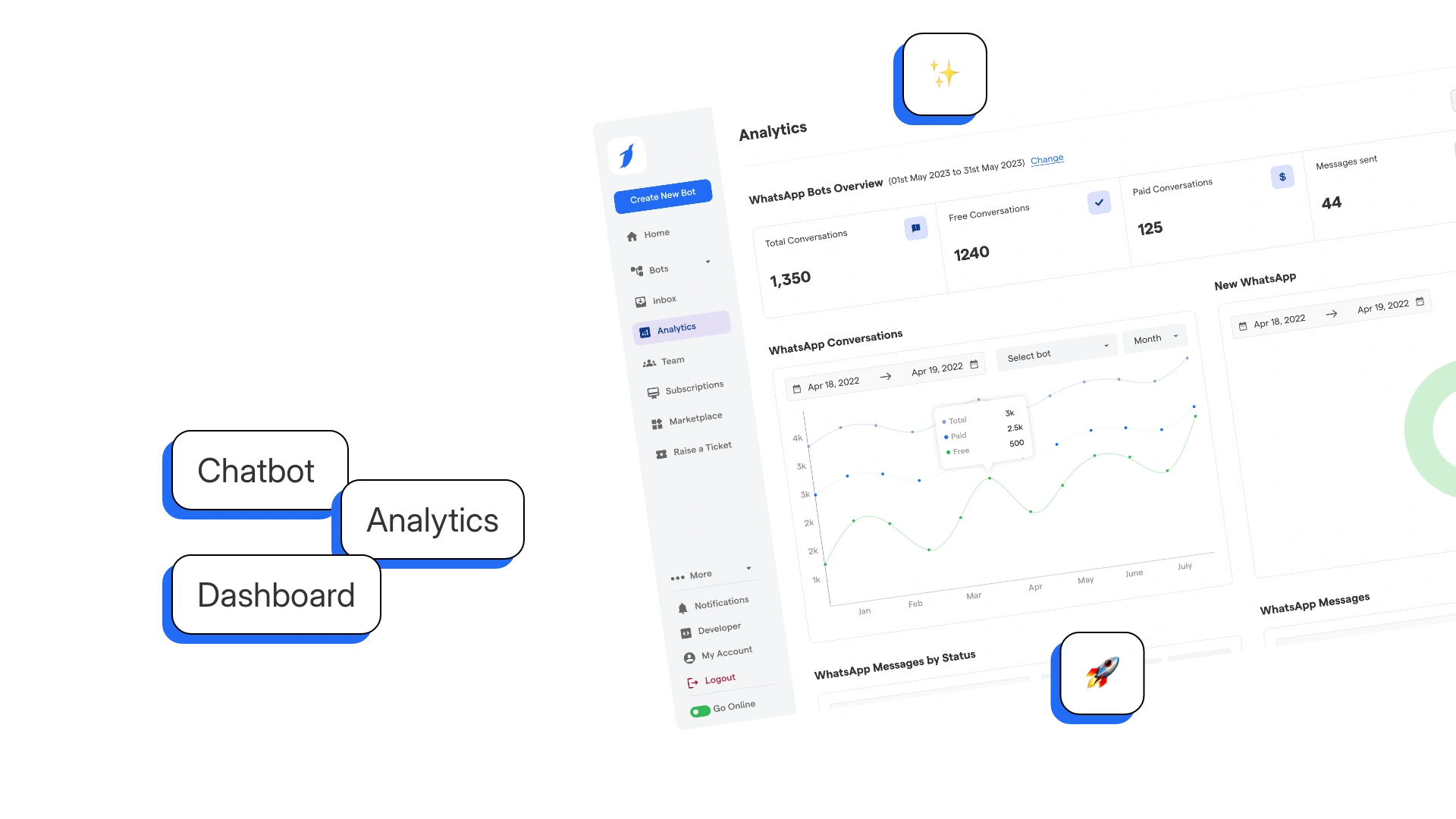
Once live, continuously monitor the HR chatbot’s performance. Analyze data on query resolution rates and employee satisfaction. Update content regularly to keep it relevant and add new features as needed.
If employees frequently ask about career growth, integrate training recommendations into the chatbots HR system.
Challenges and How to Overcome Them
Although HR chatbots bring numerous benefits, their implementation comes with some challenges. Let’s look at common hurdles and practical solutions.
Lack of Personal Touch
Employees might feel that an HR AI chatbot lacks empathy, especially for sensitive or complex queries. This can lead to dissatisfaction.
- Solution: Combine chatbot functionality with human interaction. For example, an HR bot can handle routine questions but escalate complex issues, such as conflict resolution or detailed career counseling, to an HR representative. This hybrid approach ensures efficiency without sacrificing the personal element.
Technical Issues
Glitches or downtimes can frustrate employees and disrupt workflows. If the chatbot for HR frequently fails to respond or provides incorrect information, trust in the system erodes.
- Solution: Invest in a reliable platform like BotPenguin or Microsoft Bot Framework. Regular maintenance and updates ensure the human resources chatbot runs smoothly.
Simulated testing for different scenarios also helps identify and resolve potential issues before they arise.
Employee Resistance
Some employees may be hesitant to use chatbots in HR, viewing them as impersonal or complicated to navigate. Resistance can slow adoption and limit the effectiveness of the HR chatbot.
- Solution: Educate employees on the HR chatbot benefits and demonstrate how easy it is to use. For example, show how the chatbot can instantly answer common questions like “What’s my remaining PTO?” or assist with tasks like submitting leave requests. Highlighting convenience and time savings can encourage adoption.
Limited Knowledge Base
If the chatbots HR system provides outdated or incorrect information, it undermines its reliability. This is particularly true during onboarding or when sharing company policy updates.
- Solution: Regularly update the HR chatbot with the latest HR data, FAQs, and resources. Assign a team member to oversee content updates.
For instance, when new benefits are introduced, ensure the chatbot’s responses reflect the changes. This keeps it relevant and trustworthy.
Conclusion
An HR chatbot is no longer a luxury but a necessity for businesses aiming to streamline operations and enhance employee experience. From recruitment to engagement, it automates tasks, saves time, and boosts satisfaction.
If you’re ready to adopt an HR AI chatbot, consider BotPenguin. This no-code platform lets you create powerful chatbots effortlessly.
Whether for recruitment, onboarding, or employee support, BotPenguin enables businesses to build tailored solutions without technical expertise.
With tools like BotPenguin, adopting chatbots for HR becomes simple, helping your organization stay efficient, responsive, and ready for the future.
Frequently Asked Questions (FAQs)
How does an HR chatbot improve employee experience?
An HR chatbot revolutionizes employee interaction by providing instant, 24/7 support across multiple platforms.
Employees can quickly access critical information about policies, benefits, and organizational processes without waiting for traditional HR response times.
The chatbot's intelligent design ensures personalized, accurate responses that enhance overall workplace communication and employee satisfaction.
What types of tasks can an HR chatbot handle?
HR chatbots are versatile digital assistants capable of managing a wide range of administrative tasks seamlessly.
These include processing leave applications, updating personal information, scheduling interviews, answering policy-related queries, and providing onboarding support for new employees.
The chatbot's ability to integrate with existing HR systems ensures efficient, error-free task completion.
Are HR chatbots secure for handling sensitive information?
Modern HR chatbots incorporate advanced security protocols to protect employee data with the highest level of encryption and privacy standards.
Multi-factor authentication, strict access controls, and compliance with global data protection regulations ensure that sensitive personal and professional information remains completely confidential. The system maintains rigorous security measures throughout every interaction.
How does artificial intelligence enhance HR chatbot capabilities?
Artificial intelligence enables HR chatbots to understand complex language nuances, learn from previous interactions, and provide increasingly sophisticated responses.
Machine learning algorithms continuously analyze conversation patterns, improving the chatbot's ability to interpret context, sentiment, and specific employee needs. This intelligent adaptation ensures more accurate and personalized support over time.
Can HR chatbots replace human HR professionals?
HR chatbots are designed to complement, not replace, human resources professionals by handling routine tasks and queries.
These intelligent systems free up HR teams to focus on strategic initiatives, complex problem-solving, and personal employee interactions that require emotional intelligence and nuanced understanding. The chatbot serves as an efficient support tool, enhancing rather than eliminating human HR expertise.



